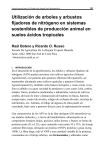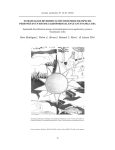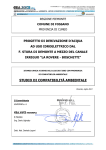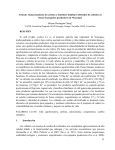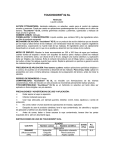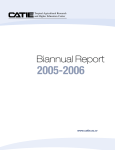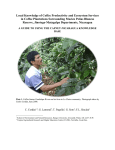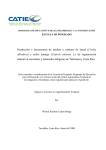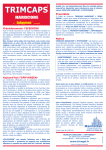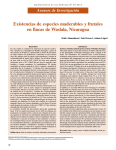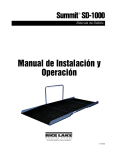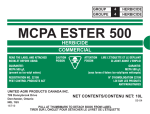Download Silvopastoral systems
Transcript
MULTI-STRATA SILVIPASTORAL SYSTEMS FOR INCREASING PRODUCTIVITY AND CONSERVATION OF NATURAL RESOURCES IN CENTRAL AMERICA Muhammad Ibrahim1, Andrea Schlonvoigt2, Juan Carlos Camargo2, and M. Souza3 Summary Conversion of primary forest to pasture is widespread in Central and Latin America and the progressive removal of trees has resulted in environmental degradation and a decline in productivity, simultaneously threatening rural livelihoods and regional biodiversity. Recently there has been keen interest to develop silvipastoral systems for sustainable animal production. Traditional silvipastoral systems are characterised with a diversity of woody perennials that plays an important role in supplying feed to animals in the dry season, production of timber, shade for animals, and in the conservation of natural resources. Improved novel woody perennials such as Morus alba (mulberry) and Trichanthera gigantea (nacedero) are characterised by high nutritive value and the use of these species as supplements for dairy and beef cattle resulted in significant improvements in animal production. Studies on tree/grass silvipastoral systems showed that the use of multi-purpose trees such as Acacia mangium contributed to higher yields (> 30%) of the associated grass and in improvements in soil quality. These silvipastoral systems have been shown to sequester significant amounts of carbon (7 to 16 tons/ha/yr) and they contribute in conservation of water resources and biodiversity. It is concluded that traditional systems are characterised with a diversity of woody perennials that have a significant value for improving animal productivity, and for the conservation of natural resources. Novel non-leguminous woody perennials are of high nutritive value and has a great potential for substituting the use of concentrates in dairy and beef farming. The selection and management of improved grasses and the management of woody perennials in silvipastoral systems can contribute in increased carrying capacities of pastures and thereby liberating fragile lands under grazing for re-afforestation. Introduction Conversion of primary forest to pasture is widespread in Central and Latin America and the progressive removal of trees has resulted in environmental degradation and a decline in productivity, simultaneously threatening rural livelihoods and regional biodiversity (Pezo and Ibrahim, 1999; Szott et al., 2000). Pasture covers more than nine million ha of Central America alone, half of which is estimated to be degraded, affecting the livelihoods of 10 million people (Szott et al., 2000). Retaining and managing trees on pasture may improve farm productivity and sustainability by generating tree products and providing ecosystem services (Ibrahim and Schlonvoigt, 1999). Within fragmented forest landscapes, farm trees may also represent critical habitats and corridors for plant and animal species, that are important for maintaining local and regional biodiversity (Harvey and Haber, 1999). Systematic research is being conducted to evaluate silvipastoral options for improving animal production and for diversification of livestock farms (Souza et al., 2000). Recently, farmers have become interested to manage trees in pasture because of their value in providing feed of a high nutritive value especially during the dry seasons, and because of their economic value as timber, carbon sequestration and conservation of biodiversity (Harvey and Haber, 1999; Souza et al., 2000). This paper presents data on traditional and improved silvipastoral systems in relation to productivity and environmental services. We hypothesised that silvipastoral systems are more productive and provide greater environmental services compared to traditional cattle production systems in Central America. Traditional systems Most farming systems in Central America include some agroforestry practices that contribute partially to their economic and biotic sustainability but the densities and configuration of trees depend on cattle production systems (Beer et al., 2000; Souza et al., 2000). Live fence post and agrosilvipastoral systems provide forage, shade for animals and other benefits. Valuable timber species, such as Cedrella odorata (Cedar), Cordia alliodora (laurel), Pithecellobium saman and Albiza spp., retained at low tree densities (4 to 15 trees ha-1), are common in the tropical lowland pastures (Barrios et al., 1999; Camargo et al., 2000, Souza et al., 2000) and in the highland regions, where intensive dairying is practised, there are good examples of planted and natural regeneration of Alnus acuminata in pastures (Russo, 1990) and Cupressus lusitanica wind breaks (Harvey and Haber, 1999). A case study conducted in San Carlos, Costa Rica showed that dual purpose cattle farmers maintained a higher proportion of timber trees in pastures which is a good indication that these farmers minimised risk by diversifying production (Table 1). Profitability of small Costa Rican dairy farms is increased, especially when labour costs increase, by diversification with high valued timber species such as C. alliodora (2,188 vs. 1,478 US$ farm-1yr-1 for farms with and without the trees) (Holmann et al. 1992). Cattle farmers may select timber species with small crowns (e.g., C. alliodora, C. odorata, Albizia spp. and Platymiscium pleiostachyum) to reduce competition with grasses for light and to sustain high yields of animal products (Harvey and Haber 1999, Souza et al. 2000). Nicaraguan and Costa Rican cattle farmers may protect timber tree seedlings in pastures (C. Barrios, pers. comm. 1999) but in one study in Costa Rica, more than 60% of the damage observed on young timber trees was due to indiscriminate chopping and herbicide use (Camargo et al. 2000). Studies conducted in the Chaco region of Argentina also showed that grazing management is crucial to promote natural regeneration of valuable timber species (Geoffroea decortican, Schinopsis balansae and Prosopis nigra) in pastures. The percentage of tree damage decreased from 65 to 48% when pasture availability increased from 3.1 to 5.0 ton DM ha-1, though some tree species were more tolerant of grazing (Simon et al. 1998). A high percentage of farmers (> 80%) in Central America manage trees in pastures to provide shade for animals especially in the hot regions (Harvey and Haber, 1999; Souza et al., 2000). Milk yields of dairy cows with access to tree shade were 20% higher compared to yields obtained from cows without shade (Souza et al. 1999). In many traditional systems in the seasonally dry pacific Pacific regions, multipurpose trees (e.g. Guazuma ulmifolia, Brosimum alicastrum, Pithecellobium saman and Enterlobium cyclocarpum) produce fodder and fruits high in energy (IVDMD = 55 – 80%) and crude protein (14 –25%), that are consumed by a animals (Benavides, 1994; Ibrahim et al., 1998). A recent study in the dry pacific regions of Nicaragua showed that farmers maintained Acacia pennatula (30 – 40 adult trees/ha) in pastures because the fruits of this species supply feed to the animals in the dry season when yields of Hyparrenhia rufa fall. Fruit yields of A. pennatula varied between 28 and 35 kg/tree (Casasola, 2000). A study is being conducted to evaluate the role of this species in conservation of biodiversity. Current research trends in CATIE and the national agricultural research institutions are providing a better understanding of some of the more traditional agroforestry practices. This is leading to the devel pment of new alternatives involving woody perennials for more productive and sustainable animal agricultural systems. Moreover, increasing timber prices provide important economic incentives to adopt silvipastoral systems (Ibrahim et al., 2000 a). In addition to the forage, fuel wood or timber qualities, other characteristics of the tree and shrub species have to be considered in developing silvipastoral systems. Research Advances Domestication of woody species Generally grass is the main feed source in traditional livestock production systems, and livestock production is constrained by poor nutrition especially during the dry season when there is a severe shortage of feed on pastures (Ibrahim et al., 2000b). There has been considerable research to evaluate woody forage perennials for their use as dry season supplements because many of these species (e.g. Cratylia argentea, Leucaena leucocephala, Erythrina spp and Gliricidia sepium) are more productive and have relatively high nutritive value (Table 2) compared to tropical grasses (e.g. Hyparrenhia rufa) (Ibrahim et al., 1998; Ibrahim et al., 2000 b). Management of fodder trees and shrubs in high densities (20,000 to 40,000 plants-ha) with adequate prunning or grazing can result in production of 7 to 14 tons edible DM/ha/yr (Benavides, 1994; Ibrahim et al., 2000 c). Some novel woody non-leguminous woody fodder species such as mulberry (Morus alba) and nacedero (Trichanthera gigantea) are of higher nutritive value (IVDMD > 70%; CP > 14%) than most leguminous woody perennials, and can be used as substitutes for concentrates in intensive dairying (Jimenez et al., 1998, Flores et al., 1998). Mulberry requires fertile soils and adequate fertiliser management (ie. 300 kg N/ha/yr) to sustain high DM yields of 12 to 16 tons edible DM/ha/yr (Espinosa and Benavides, 1996). In general the use of fodder trees as a supplement increased milk yields by 18 to 25%, but the use of mulberry have resulted in greater increases (> 50%) in milk production (Ibrahim et al., 1998). Ste rs fed mulberry as a supplement increased daily liveweight gains linearly from 0.39 to 0.95 kg/animal as the level of mulberry offered increased from 0 to 2.8 kg/100 kg LW (Table 3). In Central America and in Cuba, there are good examples where commercial dairy farms are using mulberry as a supplement for dairy cows (Ibrahim et al., 1998; Hernandez et al., 1999). Cratylia argentea, a drought tolerant shrub, has great potential for seasonally dry areas with marginal soils On-farm studies conducted on hillsides of the Pacific region of Costa Rica showed that foliage of C. argentea (multipurpose species), used as a dry season supplement for animal feeding, resulted in significant improvements (> 30%) in intake of dried Hyparrenhia rufa grass (Ibrahim et al., 2000b). The use of C. argentea and sugar cane as supplement for dual purpose cows in the dry season resulted in daily milk yields of 5 to 6.5 kg/cow/day which is of much significance considering cows usually produce an average of 3 kg/cow/day in the dry season. There has been only a few studies in Central America to determine the effect of grazing on the performance of fodder species. Mochiuti (1995) made a detailed study to determine the effect of three grazing intensities (63, 42 and 21 AU/day/ha) on the persistence and productivity of Gliricidia sepium. The data showed that high grazing intensities resulted in high stem mortality (> 18%) and low yields but moderate grazing intensities did not significantly affect productivity of Gliricidia. In another study Ibrahim et al., (2000) noted that DM yields of Erythrina beteroana declined linearly in time (> 70%) with frequent grazing (every 3 months) but high yields were sustained (> 3.5 tons/ha/ every 4 months) with a four month grazing interval. The successful establishment of trees in pastures depends on the palatability of the species and level of physical damage caused to trees during grazing. An experiment in the humid tropics of Costa Rica to determine grazing tolerance of trees (Erythrina berteroana and G. sepium) sown in a silvipastoral system with Brachiaria brizantha, showed that E. berteroana tolerated high stocking rates (3 AU/ha) and it sustained high yields during the grazing period. On the other hand G. sepium was overgrazed and it disappeared in the pasture after the second grazing year. Stem densities of G. sepium declined linearly in time (y = 504 – 234x) (Abarca unpubl.). Tree/pasture systems The integration of multipurpose tree/shrubs in pastures are known to increase pasture DM yields and are involved in soil improvements. Shade tolerant grasses (Panicum maximum and B. brizantha) and legumes (e.g. Arachis pintoi) have been selected for these systems (Zelada and Ibrahim, 1997; Bustamente et al., 1998). Experiences under humid conditions showed that improved grasses produced significantly higher DM yields in association with Erythrina poeppigiana (multipurpose tree), except some species (Pennisetum purpureum cv. Mott and B. dictoyneura) which had lower yields in mixed compared to pure stands grown in full sunlight (Table 4). A high percentage of pastures are found on acid soils and the integration of fast growing multipurpose trees such as Acacia mangium with acid tolerant grasses (e.g. Brachiaria humidicola), has shown great potential for increasing productivity of these soils (Velasco et al., 2000). A study conducted on acid soils of Panama showed that DM yields of B. humidicola was higher (> 30%) in mixture with A. mangium compared with the monoculture, and the grass had higher crude protein in the mixture (3 vs 4.8% total biomass). Higher DM yields of the silvipastoral system was associated to improvements in soil N and P and higher soil moisture compared to the grass monoculture, especially in the dry season (Bolivar et al., 1999; Velasco et al., 1999). On more fertile soils, the integration of multipurpose trees (G. sepium and E. berteroana) in B. brizantha pastures did not show additional benefit in increasing pasture productivity when compared with mixtures of pastures with Arachis pintoi (Esquivel et al., 1998), although mixtures with E. berteroana contributed to higher soil Mg. Grazing of forest plantations (e.g Tectonia grandis) to reduce risk of fires, for weed control, and short term generation of income was also studied. In Turrialba, Costa Rica, the relationship between productivity of swards of Panicum maximum and stand density of Pinus caribaea were analysed by means of linear and non-linear regression techniques comparing the following g potential predictors: basal area; Reineke stand density index; canopy cover factor; relative spacing index; and biomass of leaves (Gallo et al., 1999). The results showed that the relationship between tree basal area (x, m2 ha-1) and daily growth rate (y; kg MS ha-1 day-1) of P. maximum gave the most reliable prediction of gross productivity (y = 28.76 – 1.08 x). Environmental services of silvipastoral systems Generally, incentive systems support pure forestry, i.e. natural regeneration and forest plantation systems. Agroforestry systems, which combine elements of forestry and agriculture, are not considered. The identification, negotiation and sale of environmental services of these agroecosystems, as part of the reforestation efforts, is a major concern in today‘s development of sustainable production systems (Aguirre, 2000). The general hypothesis is, that silvipastoral systems which are known as shelterbelts or living fences in pasture landscapes, forest plantations with interplanted fodder or grazing, fodder banks of woody and herbaceous species, dispersed trees from natural or artificial regeneration on pastures, do provide important environmental services, which justify their consideration for forestry incentive programmes. The following sections will analyse how silvipastoral systems provide environmental services in livestock farms. Conservation of water resources The watersheds play the most important role in capturing the water resources. At the watershed level, the vegetation, namely the forest ecosystems maintain the hydrological cycle (Walling 1980). The cloud forests species are adapted to satisfy their water needs via interception of water from the clouds, as they are generally swathed in clouds or mist. Under normal rainfall conditions, interception of precipitation by forest crowns reduces the amount of water which reaches the soil, where conifers retain more water than angiosperms. Short rainfalls or small raindrops are subject to high relative interception rates. Trees affect water in several ways: as barriers which control runoff, as covers which reduce rain drop impact, as soil improvers which increase infiltration and water retention (Young 1997). Well managed pure pastures with low stocking rates, which maintain a closed vegetation cover throughout the year, are as well efficient in water collection, as will be shown later. Remnant trees and forest patches on the slopes improve water infiltration into the soil. Gallery forests along the natural and artificial water channels stabilize these, provide guided water transport to the rivers and reduce erosion. Evapotranspiration rates are lower in pasture-shade-systems than pure pastures, especially where these are exposed to strong winds. This leads to higher soil moisture under the tree crowns, compared to the open field. With increasing tree age (= tree growth) the positive impact on soil moisture may increase (Rhoades 1995). In a watershed without any trees the impact of heavy tropical precipitations would be direct, without any mitigation from the forest vegetation. Under pasture with increasing animal stocking rates soil compaction increases leading to greater soil runoff. At some stage, severe soil erosion is the result, leads to the sedimentation of rivers and sets an end to hydrological energy projects, availability of potable and irrigation water. Repeated events will lead to the degradation of the watershed. Under these conditions, the sustainable management of pasture systems should include forest components or alternate at least with forest fragments, in order to sustain the productive basis for ecological and human needs. However, at the cloud forest level, the situation might be different. In Villa Mills, Costa Rica, at 2600 to 2800 masl, a natural cloud forest with zero exploitation restored water resources at about 7600 m3 ha-1, while the extraction of 20 or 30 % of the basal stem area led to about 10500 and 9300 m3 ha-1, respectively (Turcios 1995). The higher values under exploitation are related to less interception rates (34 % without any exploitation, 24 or 25 % with 20 or 30 % explotation, respectively). A pasture in the same region, managed at low stocking rates (0.5 and 0.6 Animal units), preserved more water (12800 and 9800 m3 ha-1 a-1, respectively) than the forest ecosystem (Turcios 1995), which could be explained with the less interception of water from clouds, which also is not lost to to the atmosphere, but led to the soil due to the erect growth habit of the grasses which dominate pastures plant societies. ⇒ Silvipastoral systems can conserve water resources, e.g. in watershed areas through increased water infiltration, interception, reduced erosion and evapotranspiration. Pure pastures with low stocking rates might be superior in water collection, at least in cloud forest zones. Conservation of soil resources More than 35 % of the pastures in Central America present signs of more or less advanced degradation (Szott et al. 2000). Multipurpose trees (e.g. N-fixing timber trees) have the potential to rehabilitate these sites and provide economic viability of the production system. On acid soils, Acacia mangium has proven potential to increase the phosphorus and nitrogen content of the soil under pasture of Brachiaria humidicola. Only on fertile soils, silvipastoral systems with Brachiaria brizantha and multipurpose trees like Erythrina berteroana or Gliricidia sepium achieved similar nutrient levels as improved pastures with herbaceous legumes like Arachis pinto (Esquivel et al., 1998). For higher elevations, which correspond to the dairy production, the inclusion of Alnus acuminata in pastures, has shown potential to restore soil fertility (Russo 1990). NO3- N in pasture soils was four times higher under the canopies of Inga sp. compared to open pasture, and nitrification was five times higher for natural and laboratory incubation (Rhoades et al. 1998). The authors suggest, that the increased soil-N transformations under Inga are derived from improved soil rather than microenvironmental conditions. A non-N-fixing species, Psidium guajava, didn’t provide these services in the same study. As valid for any production system, the import and export of nutrients in silvipastoral systems needs to be monitored. Cut-and-carry systems without fertilization may result into a negative nutrient balance and lead to soil degradation in silvipastoral systems. Frequently, the amount of nutrients captured by the trees are not sufficient to restore the nutrients lost by the exported yields (Benavides et al. 1994). Silvipastoral systems, which involve windbreaks, reduce eolic erosion (Nair et al. 1995). On slopes, live fences in contour lines reduce soil erosion, especially in those areas, where the pasture cover is lost or burnt by the end of the dry season, and the soil is exposed to the rainfalls at the beginning of the rainy season. Tree prunings applied as mulch, reduce the kinetic energy of the raindrops on the soil particles. Tree crowns also serve as a shield against heavy rainfalls and mitigate the impact of raindrop intensity. Remnant trees and forest patches on the slopes are important barriers to soil erosion, as long as they increase the water infiltration of the soil. Otherwise, single trees may even favour soil erosion, when they present an obstacle on the slope which increases the velocity of running surface water and by this means initiate soil erosion around the tree base (Glover, 1989). ⇒ Silvipastoral systems with multi purpose tree species do conserve soil resources on fertile soils and rehabilitate soil fertility on acid soils, through improvements in soil organic matter, biological nitrogen fixation and increased phosphor absorption. Well designed live barriers control soil erosion on hill slopes, while single trees can provoke the reverse. Carbon sequestration In Latin America, between 1850 and 1985, land use changes account for a liberation of 30 Pg of carbon (C) to the atmosphere (Houghton et al. 1991). A significant contribution comes from the conversion of forests to pastures. The carbon loss is related to the removed vegetation and the loss of soil organic matter. Pasture species with a low biomass production (Axonopus compressus) lead to higher carbon emissions from the soil, than high productive species like Brachiaria dictyoneura (Veldkamp 1993, 1994). The reverse conversion of pastures to silvipastoral systems (e.g. forest plantations with grazing or fodder production, natural regeneration of forest species on pastures) may even further reduce the carbon loss from the soil. A five-yearold plantation of Acacia mangium on an acid soil conserved higher organic matter in the soil than the pure pasture (Camero et al. 2000). On the other hand, on a medium fertile alluvial soil, a three to more than seven-year-old natural regeneration of C. alliodora growing with P. maximum obtained similar values of soil organic matter compared to pure pasture (180 – 200 Mg C ha-1; Lopez et al. 1999). The increase of the vegetation cover, as the case in the conversion of pure pastures into silvipastoral systems, increases the sequestered amount of carbon. Winjum et al. (1992) estimate, that reforestation, agroforestry and forest protection on 300 to 600 mill. ha in the tropics would conserve and sequester 36 – 71 Pg of carbon for more than 50 years. Dixon (1995) provides a similar range, where 500 – 800 ha under sustainable forest or agroforestry management throughout the world would potentially sequester 0.5 - 1.5 Pg C a-1. The amount of fixed C by trees depends on species characteristics, like growth rate and longevity, as well as site conditions like location, climate, rotation (Table 5 ). Tropical forest plantations are the most effective in C sequestration. Thus, grazing of forest plantations, or systems of natural regeneration of pioneer species like Cordia alliodora, which form pure uniform stands, will provide the highest increments (Burger, 1994). Forest plantations with pastures might sequester 25-50 Mg ha-1 a-1 (Table 6). Other systems with low tree densities like live fences, shelterbelts or dispersed trees are not that efficient (3 – 25 Mg ha-1 a-1). ⇒ Silvipastoral systems can sequester carbon. The efficiency of the system depends on the growth rate, longevity and stand density of the tree species, biomass production of the pasture species, climate and soil conditions. The most efficient systems are forest plantations which are used for grazing or fodder production. Conservation of biodiversity. In comparison to tropical forests extensive areas of pure pastures only provide habitats for very few species. In the dry forest zone the pastures are managed with annual fires, thus encouraging the sprouting of the pasture. The few woody fire tolerant species with no productive use, which germinate after the fire, are generally eliminated manually, in order to reduce competition with the pasture plants. In these areas, the diversity of plant and related animal species is decreasing continuously. In the cloud forest zone of Monteverde, Costa Rica, 190 different forest species were identified on 240 ha of pasture which had been under dairy production for 30 years (Harvey et al. 1998). However, the tree number per farm was very variable (7 – 90 trees farm-1), as was the tree density (5 – 80 trees ha-1). The trees had different utilities like shade for the cattle, wood, posts, firewood, shelterbelts or bird nutrition. At first sight, these trees seem to be a relevant contribution to the local biodiversity. However, a closer look at the natural regeneration showed, that tree seedlings and young trees were very rare, probably due to grazing and weeding of the pastures. Without natural regeneration these silvipastoral systems will loose biodiversity as soon as the old trees die. Silvipastoral systems are often identical with line plantings, live fences or shelterbelts. These systems are designed by man and modified in time by nature. If they are used to connect forest patches, they can serve as corredors to animals and plants (Burel, 1996). These corridors have the objective, that the animals move from one patch to the other, but don’t adopt it as a habitat, in order to achieve the genetic exchange between populations of fragmented patches, thus guaranteeing their future survival. If the animals adopt the line plantings as habitat, than these don´t serve as corridors (Schlönvoigt and Schlönvoigt 2000). In Monteverde, 89 different bird species found their habitat in forest shelterbelts associated with pasture (Harvey 2000). 25 % of a total of 400 plant species known for Monteverde regenerated in the shelterbelts. Silvipastoral systems with dispersed trees hardly support the distribution of seeds, especially, those which are transported by wind, because the regeneration on the extensive ranchlands is lost to trampling, fire, eating or weeding. ⇒ Silvipastoral systems can help to conserve biodiversity in fragmented agricultural landscapes. The level of efficiency depends on the objective of the production system, which design fits best to the farmers needs and how far this is compatible with the conservation aim. The most promising systems are line plantings, in the bests case connected with forest patches, forest plantations and secondary forests with grazing. Conclusions Traditional systems are characterised with a diversity of woody perennials that have a significant value for improving animal productivity, and for the conservation of natural resources. Novel non-leguminous woody perennials are of high nutritive value and has a great potential for substituting the use of concentrates in dairy and beef farming. The selection and management of improved grasses and woody perennials and their management in silvipastoral systems can contribute in increased carrying capacities of pastures and thereby liberating fragile lands under grazing for reafforestation. References Aguirre, J.A. 2000. Cuencas hidrográficas, servicios ambientales e incentivos para el desarrollo ganadero sostenible del trópico Americano. In: Intensificación de la ganadería en Centroamérica: beneficios económicos y ambientales. Pomareda, C., Steinfeld, H. (eds.), CATIE, FAO, SIDE. Turrialba, Costa Rica. pp. 77-89 Barrios, C., Beer J. and Ibrahim M. 1999. Pastoreo regulado y bostas del ganado para la protección de plántulas de Pithecolobium saman en potreros. Agroforestería en las Américas, 6(23): 63 – 68. Beer, J., Ibrahim M. and Schlonvoight A.. 2000. Timber production in tropical agroforestry systems of Latin America. In Forest and Society: the role of research, XXI IUFRO World Congress 2000, 7-12 August 2000, Kuala Lumpur, Malaysia. Subplenary sessions, p. 777-786. Benavides, J. 1994. La investigación en árboles forrajeros. In: Benavides, J. (Ed.). Arboles y Arbustos en América Central. Informe Técnico no 236. C.R., Turrialba, CATIE. p. 3-28 Benavides, J., Lachaux M. and Fuentes M. 1994. Efecto de la aplicación de estiercol de cabra en el suelo sobre la calidad y producción de biomasa de morera (Morus sp.). In: Arboles y arbustos forrajeros en América Central. Benavides, J.E. (ed.), CATIE, Serie Técnica, Informe Técnico No. 236, 2: 495-514 Bolivar D. , Muhammad I., Kass D., Jiménez F. and Camargo, J.C. 1999. Productividad y Calidad forrajera de Brachiaria humidicola en monocultivo y en asocio con Acacia mangiun en un suelo ácido en el trópico húmedo. Agroforestería en las Américas, 6(23): 48-50. Burel 1996. Hedgerows and their role in agricultural landscapes. Critical Reviews in Plant Sciences 15, pp. 169-190 Burger, D. 1994. Reafforestation and other forestry CO2 strategies. Plant Research and Development 4, pp. 37-47 Bustamante, J, Ibrahim M. and Beer J. 1998. Evaluación agronómica de ocho gramíneaas mejoradas en un sistema silvopastoril con poró (Erythrina poeppigiana) en el trópico húmedo de Turrialba. Agroforestería en las Américas 5(19): 11-15. Camargo, C., Ibrahim M., Somarriba E., Finegan B. and Current D., 2000. Factores ecológicos y socioeconómicos que influyen en la regeneración natural de laurel (Cordia alliodora) en sistemas silvopastoriles del trópico húmedo y sub-húmedo de Costa Rica. Agroforestería en las Américas, 7 (26): 46 – 52. Camero, A., Camargo J.C., Ibrahim M. and Schlönvoigt A. 2000. Agroforestería y sistemas de producción animal en América Central. In: Intensificación de la ganadería en Centroamérica: beneficios económicos y ambientales. Pomareda, C., Steinfeld, H. (eds.), CATIE, FAO, SIDE. Turrialba, Costa Rica. pp. 177-198. Camero, L.A. 1991. Evaluación del poró (Erythrina poeppigiana (Walpers) O.F. Cook) y madero negro (Gliricidia sepium (Jacq.) Steud.) como suplemento proteicos para vacas lecheras alimentadas con heno de jaraguá (Hyparrhenia rufa). Tesis Mag. Sc. Turrialba, C.R., CATIE. 92p. Casasola, F. 2000. Productividad de los sistemas silvopastoriles tradicionales en Moropotente Estelí, Nicacagua. 35 p. (In press). Corado, L.H. 1991. Efecto de cuatro niveles de pulidura de arroz sobre la producción de leche de vacas en pastoreo, suplementadas con follaje de poró (Erythrina poeppigiana (Walpers) O.F. Cook). Tesis Mag. Sc. Turrialba, C.R., CATIE. 95p. Dixon, R.K. 1995. Agroforestry systems: Sources or sinks of greenhouse gases?. Agroforestry systems 31: 99-116. Espinosa, E. and Benavides B. 1996. Efecto del sitio y nivel de fertilización nitrogenada sobre la producción y calidad de tres variedades de morera (Morus alba L.) Agroforestería en las Américas, 11-12: 24-27. Esquivel, J., Ibrahim M., Jiménez F. and Pezo D. 1998. Distribución de Nutrientes en el suelo en asociaciones de poró (Erythrina berteroana), madero negro (Gliricidia sepium) o Arachis pintoi con Brachiaria brizantha. Agroforestería en las Américas, 5 (17-18): 39-43. Estrada, X.A. 1997. Efecto de la sustitución de King grass (Pennisetum purpureum * P. thypoides) por morera (Morus sp.) sobre los parámetros de degradación y fermentación ruminal de cuatro forrajes de calidad contrastante. Tesis Mag. Sc. Turrialba, C.R., CATIE. 70p. Flores, O.I., Bolivar D., Botero J.A. and Ibrahim M.A. 1998. Parámetros nutricionales de algunas arbóreas leguminosas y no leguminosas con potencial forrajero para la suplementación de rumiantes en el trópico. Livestock Research for Rural Development (en prensa). 8p. Gallo, L., Somarriba E., Ibrahim M. and Galloway G. 1999. Productividad de Panicum maximun bajo Pinus caribaea. Agroforestería en las Américas, 6: 57-59. Glover, N. (ed.) 1989. Gliricidia production and use. Nitrogen Fixing Tree Association - NFTA, Waimanalo, USA González, J. 1996. Evaluación de la calidad nutricional de la morera (Morus sp.) fresca y ensilada con bovinos de engorde. Tesis Mag. Sc. Turrialba, C.R., CATIE. 82p. Harvey, C. 2000. Windbreaks enhance seed dispersal into agricultural landscapes in Monteverde, Costa Rica. Ecological Applications 10:155-173. Harvey, C. and Haber W. 1999. Remnant trees and the conservation of biodiversity in Costa Rican pastures. Agroforestry Systems, 44 : 37 – 68. Harvey, C., Haber W.A., Mejías F. and Solano R. 1998. Remnant trees in Costa Rican pastures. Tools for conservation? Agroforestry Trees, July-September. pp. 7-9 Hernández D., Mirta C. and Reyes, F. 1999. Establishment of a multi-associated silvipastoral system. Pastos y Forrajes 22(2): 123 – 134. Hernández, I. 1996. Manejo de las podas de Leucaena leucocephala para la producción de forraje en el período seco de Cuba. Tesis Mag. Sc. Turrialba, C.R., CATIE. 83p. Herrera, M.Z. 1990. Análisis del comportamiento de 12 especies arbóreas de uso múltiple en Guápiles, Costa Rica. Tesis Mag. Sc. Turrialba, C.R., CATIE. 145p. Holmann, F., Romero F., Montenegro J., Chana C., Oviedo E. and Banos A. 1992. Rentabilidad de los sistemas silvopastoriles con péquenos productores de leche en Costa Rica: primera aproximación. Turrialba 42: 79 –89 Houghton, R.A., Skole D.L. and Lefkowitz D.S. 1991. Changes in the landscape of Latin America between 1850 and 1985. II. Net release of CO2 to the atmosphere. Forest Ecology and Management 38: 173 - 199 Ibrahim, M., Franco F., Pezo D., Camero R. and Araya J. 2000 b. Promoting intake of Cratylia argentea as a dry season supplement for cattle grazing Hyparrhenia rufa in the subhumid tropics. Agroforestry Systems (In press). Ibrahim, M. and Schlönvoigt A. 1999 Silvipastoral systems for degraded lands in the humid tropics. Environmentally friendly silvipastoral alternatives for optimising productivity of livestock farms: CATIE’s experience. In: Actas IV Semana Científica del CATIE. CATIE, Turrialba, Costa Rica. 6-9 de abril, 1999. pp. 277-282. Semana Científica (CATIE) Ibrahim, M., Abarca S. and Flores O. 2000 a. Geographical Synthesis of Data on Costa Rica Pastures and Their potential for Improvement. Quantifying Sustainable Development. The Future of Tropical Economies. Edite en Hall C. Academic Press. (U.S.A.) 423.448p. Ibrahim, M., Canto G. and Camero A. 1998. Establishment and management of fodder banks for livestock feeding in Cayo. In: Ibrahim M. and Beer J (eds.) Agroforestry prototypes for Belize. (Serie Técnica, Manual Técnico No. 28). CATIE, Turrialba, Costa Rica. pp. 15 –43. Ibrahim, M., Holman F., Hernández M. and Camero A. 2000 c. Contribution of Erythrina protein banks and rejected bananas for improving cattle production in the humid tropics. Agroforestry Systems 49: 245-254 Jiménez, M., Aguirre J., Ibrahim M. and Pezo D. 1998. Efecto de la suplementacion con morera (Morus alba) en la ganancia de peso posdestete de terneras de lecheria pp Revista Agroforesteria en las Americas 5 (17-18): 23 –28. Kürsten, E. and Burschel P. 1993. CO2 mitigation by agroforestry. Water, Air and Soil Pollution 70: 533-544 Lopez, A., Schlönvoigt A., Ibrahim M., Kleinn C. and Kanninen M. 1999. Cuantificación del carbono almacenado en el suelo de un sistema silvopastoril en la zona Atlántica de Costa Rica. Agroforestería en las Américas 6: 51-53 Lopez, G.Z., Benavides J.E., Kass M. and Faustino J. 1994. Efecto de la frecuencia de poda y la aplicación de estiércol sobre la producción de biomasa de amapola (Malvaviscus arboreus). In: Benavides, J. (Ed.). Arboles y Arbustos en América. Lopez, S. 1995. Evaluación de compuestos secundarios y consumo voluntario de cinco procedencias de Gliricidia sepium (Jacq.) Walp., en dos épocas del año, en el trópico húmedo de Costa Rica. Tesis Mag. Sc. Turrialba, C.R., CATIE. 78p. Mochiutti, S. 1995. Comportamiento agronómico y calidad nutritiva de Gliricidia sepium bajo defoliación manual y pastoreo en el trópico húmedo. M. Sc. Thesis, CATIE, Turrialba, Costa Rica. 144 p. Nair, P.K.R., Kang B.T. and Kass D.C.L. 1995. Nutrient cycling and soil erosion control in agroforestry systems. In: Agriculture and environment: bridging food production and environmental protection in developing countries. Juo, A.S.R. (ed.), ASA Special Publication 60: 117-138 Oviedo, F.J. 1995. Morera (Morus sp.) en asocio con poró y como suplemento para vacas lecheras en pastoreo. Tesis Mag. Sc. Turrialba, C.R., CATIE. 87p. Pezo, D. and Ibrahim M. 1999. Modulo de enseñanza agroforestal No 2 Sistemas silvopastoriles 2nd Ed. (Materiales de Enseñanza N°44). CATIE, Turrialba, Costa Rica, 275 p. Rhoades C., Eckert G. and Coleman D. 1998. Effect of pasture trees on soil nitrogen and organic matter: Implications for tropical Montane Forest Restoration. Restoration ecology 6 (3): 262 – 270. Rhoades, C. 1995. Seasonal pattern of nitrogen mineralization and soil moisture beneath Faidherbia albida (syn. Acacia albida) in Central Malawi. Agroforestry Systems 29:133-145. Rojas, H. and Benavides J.E. 1994. Producción de leche de cabras alimentadas con pasto y suplementadas con altos niveles de morera (Morus sp.). In: Benavides, J. (Ed.). Arboles y Arbustos en América Central. Informe Técnico no 236. C.R., Turrialba, CATIE. p. 305-320. Russo, R.O. 1990. Evaluating Alnus acuminata as a component in agroforestry systems. Agroforestry Systems 10: 241-252 Schlönvoigt, M. and Schlönvoigt A. 2000. Planung und Einrichtung von Biokorridoren. (Planning and establishment of biocorredors.). In: Naturschutz in Entwicklungsländern - Neue Ansätze für den Erhalt der biologischen Vielfalt. Deutsche Gesellschaft für technische Zusammenarbeit (GTZ) GmbH, Bundesamt fur Naturschutz (BfN), Internationale Naturschutzakademie Insel Vilm (eds.). Max Kasparek Verlag, Germany. pp. 105 -110 Simón M, Ibrahim MA, Finegan B and Pezo D. 1998. Efectos del pastoreo bovino sobre la regeneración de tres especies arbóreas comerciales del Chaco Argentino: Un método de protección. Agroforesteria en las Américas 5 (17-18): 84- 87. Souza de Abreu, M., Ibrahim M., Harvey C. and Jiménez F. 2000. Caracterización del componente arbóreo en los sistemas ganaderos de La Fortuna de San Carlos, Costa Rica. Agroforestería en las Américas, 7 (26): 53 – 56. Souza de Abreu., M., Ibrahim M. and Silva de Sales J. 1999. Arboles en pastizales y su influencia en la producción de pasto y leche. In: Memorias de VI Seminario internacional sobre sistemas agropecuarios sostenibles, CIPAV, Cali, Colombia. CD Rom. Szott, L., Ibrahim M. and Beer J. 2000. The Hamburger Connection Hangover. Cattle pasture land degradation and alternative land use in Central América. CATIE, DANIDA, GTZ. Trexler, M.C., Haugen C. 1995. Keeping it green: evaluating tropical forestry strategies to mitigate global warming. World Resources Institute, Washington, DC, USA. 52 p. Turcios, W.R. 1995. Producción y valoración económica del componente hídrico y forestal de los robledales de altura bajo intervenciones silviculturales. M.Sc.-Thesis, CATIE, Turrialba, Costa Rica. 80 p. Valerio, S. 1990. Efecto del secado y método de análisis sobre la estimación de taninos y la relación de estos con la digestibilidad in vitro de algunos forrajes tropicales. Tesis Mag. Sc. Turrialba, C.R., CATIE. 94p. Velasco, A., Ibrahim M., Kass D., Jiménez F. and Rivas G. 1999. Concentraciones de fósforo en suelos bajo sistema silvopastoril de Acacia mangium con Brachiaria humidicola. Agroforestería en las Américas 6 (23): 45 – 47 Veldkamp, E. 1993. Soil organic carbon dynamics in pastures established after deforestation in the humid tropics of Costa Rica. Ph.D. thesis, University of Wageningen, NL. 113 p. Veldkamp, E. 1994. Organic carbon turnover in three tropical soils under pasture after deforestation. American Journal of Soil Science Society 58: 175-180 Walling, E.E. 1980. Water in the catchment ecosystem. In: Water quality in catchment ecosystems. J. Wiley, New York. pp. 1-47 Winjum, J.K., Dixon R.K. and Schroeder P.E. 1992. Estimating the global potential of forest and agroforest management practices to sequester carbon. Water, Air and Soil Pollution 64: 213-227 Young, A. 1997. Agroforestry systems for soil management. 2nd. ed. CAB International, New York, USA. 320 p. Zelada, E. and Ibrahim M. 1997. Tolerancia a la sombra de especies forrajeras herbáceas en el trópico húmedo de Costa Rica. Archivos Latinoamericanos de Producción Animal (ALPA) 5: 42 –44. Table 1 - Abundance of trees by cattle production system. La Fortuna San Carlos, 1999. (Average number of trees/ ha) Trees Mixed Specialized in m lk Dual purpose production (n =3) (n=3) (n =4) Laurel Cedar Other timber trees2 Non-timber trees3 Total 1 7.33 b1 0.63 a 2.51 a 1.99 b 12.46 a 10.34 b 1.44 a 4.33 a 6.00 a 22.11 b 16.08 a 0.62 a 1.26 a 2.51 b 20.47b Values with the same letter in the same row are not significantly different (P<0.05). Lagarto, surá, gavilán and poró. 3 Limón dulce, naranja, guayaba, guava and higuerón (fruit and shade trees). 2 Table 2 - Fodder quality of some woody leguminous and non-leguminous perennials. Species Morus sp. (mulberry) Fraction Total* Total Total Total Leaves Young stems Total Leaves Young stems Total Leaves Total Total CP (%) 15.8 24.3 23.0 14.5 20.3 11.8 19.6 19.1 18.6 20.0 19.5 19.9 IVDMD (%) 63.9 74.5 80.0 60.8 74.4 67.0 73.8 81.1 60.6 81.0 77.0 77.1 67.4 Leaves 20.4 70.0 rosa-sinenis (Clavelón) Young stems Total 8.4 26.5 49.5 72.0 Malvaviscus Leaves 21.2 60.0 Young stems Comestible 9.3 20.0 Cratylia argentea Total (Cratylia) Guazuma Ulmifolia (caulote) Trichanthera gigantea (Nacedero) Hibiscus arboreus (amapola) Cratylia Gliricidia sepium (madero negro). Leucaena Leucocephala (leucaena) Erythrina Poeppigiana (poró) Calliandra Calothyrsus (caliandra) NDF 50.0 29.8 ADF Source 28.5 Estrada 1997 18.8 Flores et al 1998 Benavides 1997 Jiménez 1997 Espinosa 1996 Oviedo 1995 Benavides 1994 40.7 33.9 Flores et al 1998 Rojas et al 1994 36.7 22.3 Flores et al 1998 López et al 1994 65.0 55.2 51.0 33.9 23.8 51.8 52.0 34.4 Total Total Total NA 11.8 11.0 45.3 44.6 43.8 52.0 34.4 Total Total Total Leaves 24.3 23.2 27.2 30.3 67.4 64.7 54.3 68.2 41.0 43.0 53.3 25.1 Ibrahim et al., 2000 c Flores et al 1998 Valerio 1990 Herrera 1990 Flores et al 1998 Mochuitti, 1995 López 1995 Camero 1991 Hernández 1996 Young stems 18.5 46.9 Total Total 27.2 22.5 54.4 52.5 Total Total 18.0 30.3 22.0 34.0 NDF: neutral detergent fibre; ADF: acid detergent fibre 32.7 Corado 1991 Herrera 1990 55.4 24.3 Flores et al 1998. Table 3 - Effect of different levels of Morus alba (mulberry) on liveweight gains of steers fed a basal diet of Pennestum purpureum x P. typhoides (King grass) (source: Gonzalez, 1996) Variable 0 Intake, (kg/100 kg LW) Mulberry King grass Total intake Liveweight gain (kg/an/day) 0.00 2.04 2.04c 0.39c Treatment mulberry, kg DM/100 kg LW 1 1.9 2.8 0.90 1.79 2.69b 0.69b 1.71 1.29 3.00a 0.94a Means in the same row followed by the same letter are not significantly different 2.11 0.95 3.06a 0.95a Table 4 - Accumulated dry matter production (five cycles of harvesting) of eight improved grasses grown in full sunlight and in association with Erythrina poeppigiana plantations pruned every six months Grasses With trees (1) Without trees Difference % ( (1 – 2) / 2) Panicum maximum 29804 a * 20791 b 43 16061 Panicum maximum 27780 a 24987 b 11 16051 Brachiaria brizantha 14437 a 10471 b 38 6780 Pennisetum 14343 b 16061 a - 11 purpureum cv Mott Brachiaria 9787 a 8162 b 20 humidicola 6369 Brachiaria brizantha 8885 a 6175 b 44 664 Brachiaria 8393 b 9467 a - 11 dictyoneura 6133 Cynodon nlemfuensis 6818 a 4490 b 52 * Means in the same row followed by the same letter are not significantly different ( p < 0,05). Table 5 - Global estimates for potential carbon sequestration and conservation through different forest management practices for the period 1995 to 2050 (adapted from Trexler and Haugen, 1995) Climate zone/ Landuse Land surface Amount C sequestered or Costs Total costs practice (106 ha) conserved (Pg) $ / Mg C (109 $) Tropical zones Reduce deforestation 138 2 22 Natural regeneration 217 2 22 Forest plantation 67 7 97 Agroforestry systems 63 5 27 115 6 60 5 5 3 95 8 17 Temperate zones Forest plantations Agroforestry systems Boreal zones Forest plantations Total 700 59.9 * estimates of minimum biomas, includes 25 % of C for roots, litter and soil. 248 Table 6 - Carbon storage in the above ground biomass of trees in some agroforestry systems in Central America. (adapted from Kürsten and Burschel, 1993) Rotation Firewood Annual Agroforestry system Tree Tree Total carbon species density (# ha-1) (years) (t ha-1) carbon sequestration sequestration (t C ha-1) (t C ha-1 a-1) Shade trees Gliricidia sepium 330 30 101.4 0.7 51.6 Inga densiflora 400 20 42.8 0.5 24.3 Mimosa scabrella 650 2 18.3 2.0 24.9 Leucaena leucocephala 3800 5.0 46.2 2.0 28.9 Eucalyptus saligna 1378 2.5 41.3 3.6 27.0 Miconia lonchophylla 3400 8 54.0 1.4 31.0 Lonchocarpus sp. 7300 3 27.8 2.0 17.9 Lonchocarpus sp. 3400 3 10.6 0.8 7.6 Cassia grandis 1700 3 21.2 1.6 12.3 Guazuma ulmifolia 2850 4 5.2 0.3 5.8 35 30 18.3 0.1 25.0 Firewood plantations Secondary forests Trees in pastures Alnus acuminata



















